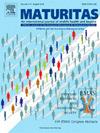韩国人口中绝经状态与自杀行为的关系
IF 3.6
2区 医学
Q2 GERIATRICS & GERONTOLOGY
引用次数: 0
摘要
目的:我们调查韩国人群中自杀行为的风险是否与绝经状态,尤其是绝经年龄有关。为了更深入地了解自杀行为,参与者被问及自杀的想法和计划,以及实际的自杀企图。方法这项以人口为基础的横断面研究纳入了27,524名妇女,分析了自杀意念,26,893名妇女进行了自杀计划,28,682名妇女进行了自杀未遂,这些妇女登记在韩国国家健康和营养检查调查(2010 - 2022)中。绝经状态的数据,包括绝经年龄和自杀行为从自我报告的问卷中获得。采用logistic回归模型检验卵巢功能不全、早期绝经和正常绝经是否对自杀行为有显著影响,并通过抑郁进一步分层。根据绝经年龄对自杀行为的加权患病率也进行了分析。结果与绝经前相比,卵巢功能不全女性的自杀意念风险增加,优势比(95%可信区间)为1.53(1.17 - 2.01),早期绝经女性的优势比为1.57(1.28-1.92),临床正常绝经女性的优势比为1.17(1.00-1.37)。自杀计划的风险在这三个绝经期组中也有所增加:1.92(1.06-3.47),1.55(0.96-2.51)和1.61(1.13-2.30)。卵巢功能不全的女性自杀的风险也增加,比值比为2.01(0.91-4.44),绝经期正常的女性的比值比为1.97(1.22-3.18)。自杀意念的加权患病率随着绝经年龄的增长而下降,分为≤30岁(21.5%)、31-40岁(14.8%)、41-50岁(11.1%)和≥50岁(9.4%)。结论卵巢功能不全、早期绝经和临床正常绝经的妇女发生自杀意念和计划的风险较高。与绝经前妇女相比,卵巢功能不全和正常绝经的妇女自杀企图的风险也更高。总体而言,绝经年龄越小,产生自杀意念和计划的风险越高。由于本研究的横断面设计的局限性,必须进行纵向研究,以更有力地建立更年期与自杀行为之间的关系。本文章由计算机程序翻译,如有差异,请以英文原文为准。
Relationship between menopausal status and suicidal behavior among the Korean population
Objective
We investigated whether, in the Korean population, the risk of suicidal behavior is associated with menopausal status and especially age at menopause. For a deeper understanding of suicidal behavior, participants were asked about suicidal ideation and plans, and actual suicide attempts.
Methods
This cross-sectional, population-based study involved 27,524 women for analyzing suicidal ideation, 26,893 women for suicidal plans, 28,682 women for suicide attempts, registered in the Korea National Health and Nutrition Examination Survey (2010−2022). Data on menopausal status, including age at menopause, and suicidal behavior were obtained from a self-reported questionnaire. A logistic regression model was applied to examine whether premature ovarian insufficiency, early menopause, and normal menopause significantly impact rates of suicidal behavior, which was further stratified by depression. Weighted prevalence of suicidal behavior according to age at menopause was also analyzed.
Results
Compared with premenopausal status, the risk of suicidal ideation was increased in women with premature ovarian insufficiency by an odds ratio (95 % confidence interval) of 1.53 (1.17–2.01), in women with early menopause by 1.57 (1.28–1.92), and in women with clinically normal menopause by 1.17 (1.00–1.37). The risk of suicidal planning was also increased in women in each of these three respective menopausal groups: 1.92 (1.06–3.47), 1.55 (0.96–2.51), and 1.61 (1.13–2.30). The risk of suicide attempt was also increased in women with premature ovarian insufficiency, by an odds ratio of 2.01 (0.91–4.44), and in women with a clinically normal menopause, by 1.97 (1.22–3.18). The weighted prevalence of suicidal ideation decreased with age at menopause, grouped as 30 (21.5 %), 31–40 (14.8 %), 41–50 (11.1 %), and 50 (9.4 %).
Conclusion
The risks of suicidal ideation and planning were higher in women with premature ovarian insufficiency, early menopause, and clinically normal menopause. The risk of suicide attempt was also higher in women with premature ovarian insufficiency and normal menopause, compared with premenopausal women. Younger age at menopause led to a higher risk of suicidal ideation and planning in general. Due to the limitations of this study's cross-sectional design, longitudinal studies must be conducted to establish more strongly this relationship between menopause and suicidal behavior.
求助全文
通过发布文献求助,成功后即可免费获取论文全文。
去求助
来源期刊

Maturitas
医学-妇产科学
CiteScore
9.10
自引率
2.00%
发文量
142
审稿时长
40 days
期刊介绍:
Maturitas is an international multidisciplinary peer reviewed scientific journal of midlife health and beyond publishing original research, reviews, consensus statements and guidelines, and mini-reviews. The journal provides a forum for all aspects of postreproductive health in both genders ranging from basic science to health and social care.
Topic areas include:• Aging• Alternative and Complementary medicines• Arthritis and Bone Health• Cancer• Cardiovascular Health• Cognitive and Physical Functioning• Epidemiology, health and social care• Gynecology/ Reproductive Endocrinology• Nutrition/ Obesity Diabetes/ Metabolic Syndrome• Menopause, Ovarian Aging• Mental Health• Pharmacology• Sexuality• Quality of Life
 求助内容:
求助内容: 应助结果提醒方式:
应助结果提醒方式:


